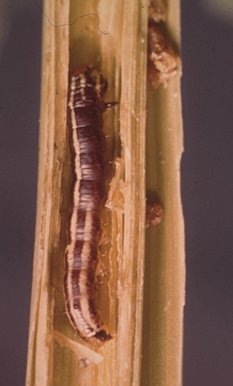
Unrolling the whorl or damaged plants will usually reveal the borer. Small larvae are cream colored with a dark brown or purple band around the body. Several dark lengthwise stripes may be present. Full grown larvae may lack the dark stripes and band, making them harder to identify. Common stalk borer larvae are usually very active when handled.
Common Stalk Borers can be damaging in no-till or reduced tillage popcorn.
Damage to popcorn caused by the common stalk borer is characterized by wilting and/or
dying of the upper leaves or by ragged irregular holes chewed in the newly unrolled leaves. The characteristic
"dead heart" is caused by the insect boring into the stalk at the soil level and tunneling upward. It may also climb up
the plant and tunnel downward into the whorl, creating the ragged holes. A considerable amount of "frass", or
sawdust-like borer feces, can be seen in the whorl or coming out of the borer's entry hole in the stalk. Popcorn plants
from 2 to 24 inches tall may be attacked. In conventional popcorn, damage is usually confined to weedy border rows
along fences, grass waterways and contour strips, while weedy no-till fields may have damage throughout.
Plants damaged by stalk borers are often stunted and/or misshapen and may die.
Infested plants (if they survive) may or may not produce harvestable ears. If they do, ears are usually smaller than
normal. Those plants that do not produce ears compete with productive plants for water, nutrients and sunlight.
Control is difficult once the larvae have become established in corn plants. Treatment is most successful when applied just prior to the borers entering the plants. Most insecticides labeled for cutworm control are labeled for stalk borer.
See ENTFACT - 100, Common Stalk Borer for more information.